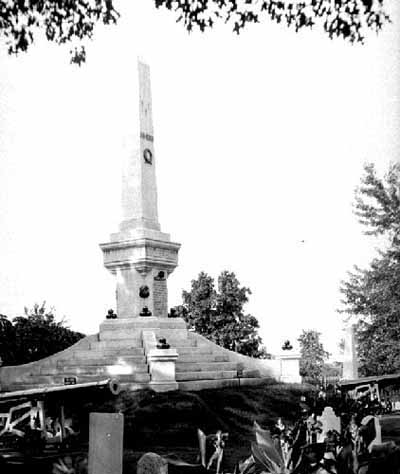Battle of Lundy's Lane National Historic Site of Canada
Niagara Falls, Ontario

General view
(© Archives of Ontario / Archives publiques de l'Ontario, F 1075-13, H 1065, 1925.)
Address :
Niagara Falls, Ontario
Recognition Statute:
Historic Sites and Monuments Act (R.S.C., 1985, c. H-4)
Designation Date:
1937-05-20
Dates:
-
1814 to 1814
(Significant)
Event, Person, Organization:
-
War of 1812
(Event)
-
Lieutenant-General Sir Gordon Drummond
(Person)
-
Major-General Jacob Brown
(Person)
-
Fort Erie
(Unknown)
-
Drummond Hill Cemetary
(Unknown)
Other Name(s):
-
Battle of Lundy's Lane
(Designation Name)
Research Report Number:
1964-017, 2007-CED/SDC-037
Plaque(s)
Existing plaque: on Lundy's Lane Monument in cemetery Niagara Falls, Ontario
This was the site of the bloodiest battle of the War of 1812. On the afternoon of 25th July, 1814, Lieutenant-General Gordon Drummond with about 2800 men engaged the invading American army which had recently been victorious at Chippewa. The armies were evenly matched and the six-hour battle lasted until darkness and heavy losses put an end to the fighting. Each force had lost over 800 men. Although each claimed victory, the Americans had failed to dislodge Drummond from his position. They withdrew the next day, ending their offensive in Upper Canada.
Description of Historic Place
The Battle of Lundy’s Lane National Historic Site of Canada is located in Niagara Falls, Ontario. The battle occurred on July 25, 1814 on what was a rise of clear farmland surrounded by an orchard and forest, situated upon Lundy’s Lane. The location of the site is now marked by a plaque located within Drummond Hill Cemetery. Lundy’s Lane was the site of a major battle between the British and American forces in which the Americans, who were advancing after the Battle of Chippewa, attacked the British defensive position that they had taken up. Following a bitterly contested engagement, the Americans withdrew. The six-hour long battle was one of the bloodiest battles of the War of 1812 and marked the end of American offensive action in Upper Canada. Official recognition refers to a parcel of land in the City of Niagara Falls that is roughly four-blocks square and encompasses the site of the battle.
Heritage Value
The Battle of Lundy’s Lane was designated a national historic site of Canada in 1937. It is designated because: it was the bloodiest battle of the War of 1812; and, the Americans failed to dislodge the British from their position, ending the American offensive in Upper Canada.
In the summer of 1814, American forces crossed the Niagara River at Fort Erie to invade Upper Canada. Advancing northward along the Niagara River, they had initial success, defeating a British force at the Battle of Chippawa. The British under Sir Gordon Drummond regrouped and on the evening of 25 July, on Lundy’s Lane almost within sight of Niagara Falls, the British regulars and Canadian fencibles and militia were attacked by the American forces. Throughout the evening the two armies attacked each other and the battle surged back and forth, especially around the field guns in what is now the Drummond Hill Cemetery. Both sides suffered heavy casualties but by midnight the Americans retired leaving the exhausted British and Canadians holding the field. The Battle of Lundy’s Lane was the bloodiest and bitterest contest of the War of 1812 and it broke the American thrust in 1814 to take Upper Canada.
Sources: Historic Sites and Monuments Board of Canada, Minutes, October 1937, October 1963, October 1966, December 2007.
Character-Defining Elements
- its location within the limits of Niagara Falls; the setting on a grassed area of the Drummond Hill Cemetery where the plaque commemorating the site is located; the location and integrity of the monument to the battle erected in 1895, and the three tablets fixed to the monument in 1935 that bear the names of the officers and soldiers of the regular regiments of the British Army and Canadian militia killed in action during the engagement; the integrity of any surviving or as yet unidentified archaeological remains which may be found within the site in their original placement and extent.